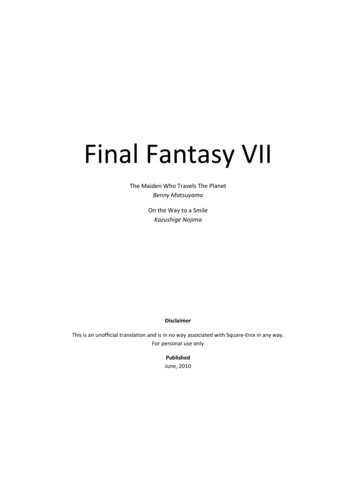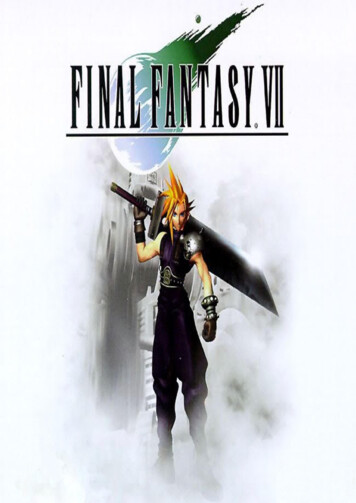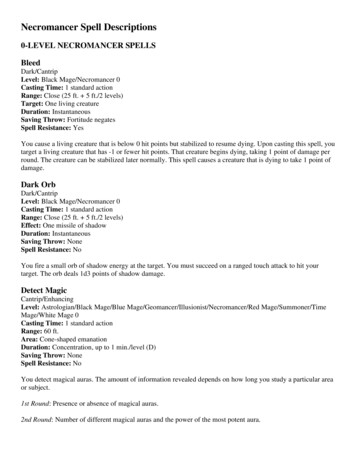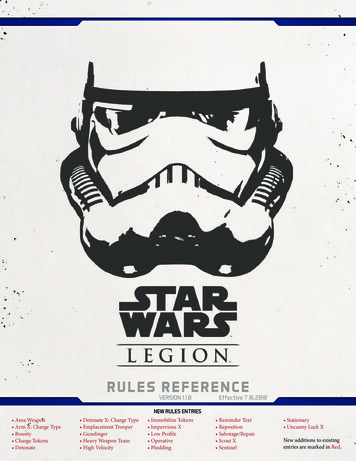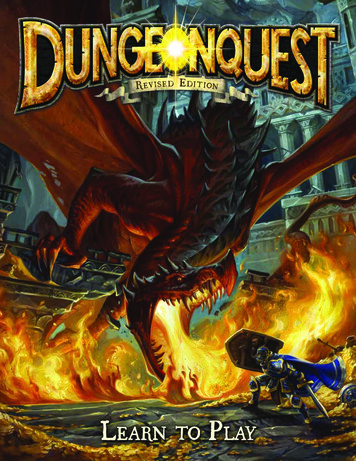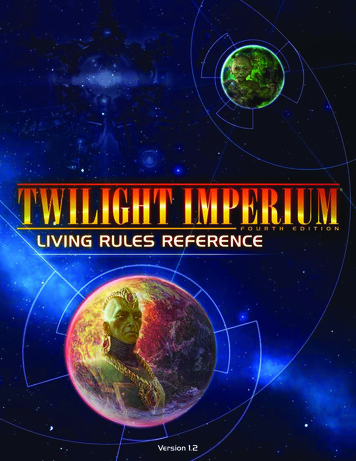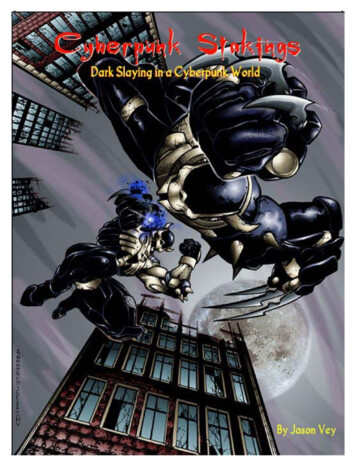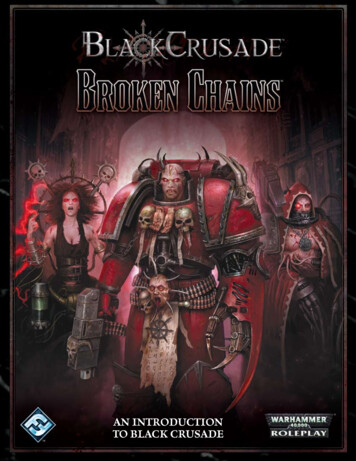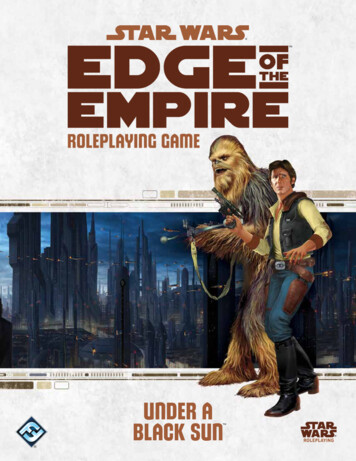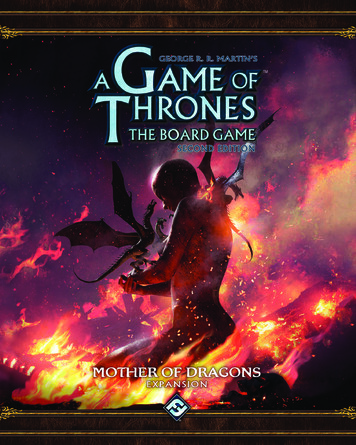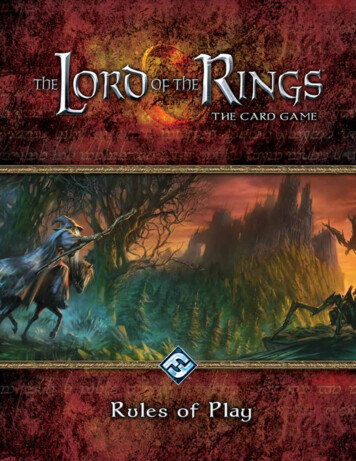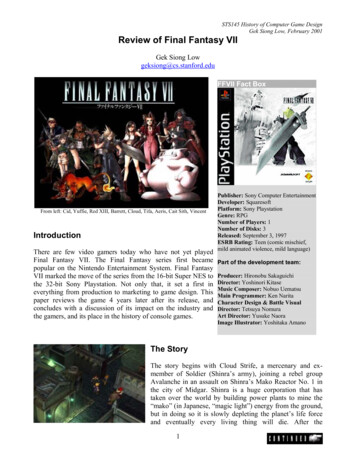
Transcription
STS145 History of Computer Game DesignGek Siong Low, February 2001Review of Final Fantasy VIIGek Siong Lowgeksiong@cs.stanford.eduFFVII Fact BoxFrom left: Cid, Yuffie, Red XIII, Barrett, Cloud, Tifa, Aeris, Cait Sith, VincentIntroductionThere are few video gamers today who have not yet playedFinal Fantasy VII. The Final Fantasy series first becamepopular on the Nintendo Entertainment System. Final FantasyVII marked the move of the series from the 16-bit Super NES tothe 32-bit Sony Playstation. Not only that, it set a first ineverything from production to marketing to game design. Thispaper reviews the game 4 years later after its release, andconcludes with a discussion of its impact on the industry andthe gamers, and its place in the history of console games.Publisher: Sony Computer EntertainmentDeveloper: SquaresoftPlatform: Sony PlaystationGenre: RPGNumber of Players: 1Number of Disks: 3Released: September 3, 1997ESRB Rating: Teen (comic mischief,mild animated violence, mild language)Part of the development team:Producer: Hironobu SakaguichiDirector: Yoshinori KitaseMusic Composer: Nobuo UematsuMain Programmer: Ken NaritaCharacter Design & Battle VisualDirector: Tetsuya NomuraArt Director: Yusuke NaoraImage Illustrator: Yoshitaka AmanoThe StoryThe story begins with Cloud Strife, a mercenary and exmember of Soldier (Shinra’s army), joining a rebel groupAvalanche in an assault on Shinra’s Mako Reactor No. 1 inthe city of Midgar. Shinra is a huge corporation that hastaken over the world by building power plants to mine the“mako” (in Japanese, “magic light”) energy from the ground,but in doing so it is slowly depleting the planet’s life forceand eventually every living thing will die. After the1
STS145 History of Computer Game DesignGek Siong Low, February 2001successful mission, Cloud agrees to join Avalanche again foranother bombing mission on another reactor but they wereambushed and he was separated from the group. He meetsthe flower-girl Aeris and finds out that Shinra is extremelyinterested in her for some unknown reason. After savingAeris from the clutches of Shinra, Cloud and the gang findout that something more sinister than Shinra is coming, andthe end of the world may come much sooner than theyexpect. This new discovery leads them on a hunt across theworld for the mysterious ex-Soldier Sephiroth, a man withlegendary abilities, and with a hidden agenda for the fate ofthe planet. But Shinra is searching for Sephiroth too, for reasons unknown, and they are out to stop theparty from reaching Sephiroth first. Along the way, questions arise about the past, and about Cloud’sreal identity. Who exactly is Sephiroth? The Ancients? Why does everything seem to hinge on oneseemingly unimportant photograph? What is the mysterious voice that plagues Cloud’s mind? Theirsearch for the truth eventually leads to the Northern Crater, into which they descend for the finalshowdown with Sephiroth.The complex story gradually unfurls primarily in the form ofcharacter flashbacks. The game is unique in that theseflashbacks are not simply telling the events as theyhappened, but what the character remembers, eitheraccurately or inaccurately, from his or her own perspective.Many of the characters’ accounts of the past are conflicting.The truth is revealed a bit at a time, to be finally resolvedonly much later. The player thus desires to know the realtruth, and is effectively drawn deeply into the game.The sacrifice for such a complex and compelling story is thenumber of possible outcomes. Final Fantasy VII has only one ending, and is a commonly heardcomplaint among the hard-core RPG players. However, I believe the sacrifice is respectable and worthit, because a simpler story or inconsistent endings would have destroyed the game, although I toowould have preferred more non-linearity in the story. Theonly major complaint I have is that the back-stories of somecharacters, in particular Tifa, are not developed as fully as Iwould have liked. However, each character’s personality isconveyed very well in the way they speak, and this is a veryrefreshing difference from other RPG games.Although the story is extremely linear and sometimespredictable (although some people have complained it wastoo complex and confusing), it was nevertheless a great storymasterfully told by some of the best people in the business.(Warning: Spoilers below! Do not read if you have not played the game!)Final Fantasy VII has several major firsts as stories in RPG games go. For example, it contains perhapsone of the most pitiable villain ever found in RPG games. We understand the need to destroy Sephiroth2
STS145 History of Computer Game DesignGek Siong Low, February 2001in order to save the planet, but we feel sorry for him too, as it is not his fault. He is a victim of Shinra’shideous experiments, misled into believing he is one of the chosen “Cetra”. Shinra’s lies, and hisobsession with his “mother” Jenova led him down the path of self-destruction. Villains have alwaysbeen extremely stereotypical in Japanese-styled RPG games (as in the “Haha! I’m going to destroy theworld! Nyah nyah!” type). No other RPG villain has even come close to Sephiroth’s depth andcomplexity, and his ability to evoke such strong feelings of sympathy in the player.For the first time in RPG history, Final Fantasy VII includesthe death of a main playable character as an essential andcritical element of the plot. Many of us still mourn Aeris’death, and many players have undoubtedly used devices suchas GameShark to “resurrect” her and put her back into theparty. Even more interesting is the existence of a hoax thatAeris can indeed be resurrected legally, complete withinstructions on how to achieve it, seemingly valid reasonssuch as the new “hidden” cinematics in the US release of thegame, and recounts of other players who claimed they did it.However, this is nothing but a hoax, and interested readers can probably find information regardingthis on the web (I recommend the GameFAQs web site).GameplayThe key to a successful RPG, in addition to its story, is itsbattle and character development system.MateriaMateria is the result of condensing “mako” energy into acrystal. Ironically, the key to success is in using up the verysame energy that Shinra is depleting. Understanding andusing materia effectively is essential to doing well in thegame.The materia system is what replaces the job- or class- based character development systems found inprevious games in the series. Final Fantasy VII utilizes a classless character development system, andalthough it makes the characters much more interchangeable, they are now more balanced, unlike olderRPG games, where a healer is ultimately useless and is a liability until someone needs healing.You use materia by equipping them on your weapons andarmor. Every weapon or armor has a number of slots inwhich materia can be attached. Each materia also contains itsown series of spells and summons. Materia gain levels themore you use them, and allows you to use stronger spells.When a materia is “mastered”, it spawns a new duplicate foryou to repeat the whole training process all over again.3
STS145 History of Computer Game DesignGek Siong Low, February 2001In addition to just level-building, materia can also be linked in pairs, if the weapon or armor providesfor that. They can have different side-effects depending on the combination, so there is a lot of roomfor experimentation and self-expression. Furthermore, any materia can be used by any character, andcan be swapped between characters, so you can reconfigure the party to deal with different situations.While not necessary to beat the game, some players havecreated really amazing materia combinations. There areFAQs all over the Internet, written by players, describing the“perfect” materia combination to, for example, to kill almostall enemies on the first strike, or even to beat Sephiroth inthe first couple of rounds without doing anything at all in thefinal battle. Of course, it takes a lot of time and patience tomaster enough materia to get the required setup. That theplayers are willing to do this proof of Square’s ingenuity andfarsightedness in creating such a flexible systemBattle systemThe Active-Time Battle system is not a new concept, as itwas used in some of the earlier games in the series. What isnew is the introduction of “Limit Breaks”, fantasticdesperation moves that a character can use if they areattacked enough times, indicated by a bar that shows thecharacter’s amount of anger. Performing enough LimitBreaks allows the character to learn new Limit Breaks, butthe player must set the Limit Break level manually,otherwise the character will not attain the next level.Mini-games, Secret Characters and Side-QuestsMini-games abound everywhere in Final Fantasy VII as partof the story-line, which includes an exhilarating bike chaseon the highway, and an underwater submarine seek-anddestroy mission. There is even a complete video game arcadein the Gold Saucer, where you can replay the mini-games orplay other games (and waste a tremendous amount of money,just as in real-life arcades).There are two optional secret characters which you can get in the game - Yuffie (an annoying femaleninja) and Vincent (a really cool undead human), each with their own set of Limit Breaks, weapons,side-quests and back-story. The most often heard complaint is that they are woefully underdeveloped.No special FMVs were made for them, their side-quests and back-story lacks substance, and they haveabsolutely no effect on the story. The only reason to get them is if you like their fighting prowess, or ifyou simply want to get every little secret in the game.4
STS145 History of Computer Game DesignGek Siong Low, February 2001ChocobosYes, they are back, and this time you can breed and racethem for additional cash at the Gold Saucer, or even breedyour very own super-duper ocean-going gold chocobo to getat that all-powerful Knights-of-the-Round materia, or theextremely useful Mime materia. Chocobo breeding (andracing) is a time-consuming and expensive commitment, butvery recommended if you want to beat Sephiroth. The otheralternative is to level up to ridiculously high levels. Eitherway, the choice is yours to make.GraphicsFreed from the size constraints of a cartridge based system,and with a budget of over 30 million and 120 artists, themost amazing CG graphics ever to be produced at that timewere achieved. FMV sequences are scattered throughout theentire game, providing a visual feast never seen before in anyRPG. These are not just cut-scenes that function as rewardsfor the player’s achievements. The movie sequences arewoven directly into the game itself, and drive the storyforward. Most players first bought the game for its beautifulgraphics, and then were wowed by the gameplay and story. Final Fantasy VII feels more like a moviethan a game, and that is probably where most of its mass-appeal lies. This use of integrated movies wascontroversial within the RPG community. Even today, there are still debates by gamers regarding themerits of such “eye candy”, and what elements make a “true” RPG.In addition to the pre-rendered FMVs, many scenes are actedout in real time 3D by the super-deformed “Popeye-like”characters themselves within the 3D game environment,complete with suitable animations, such as Barrett shakinghis fist in anger. The game is played entirely in a thirdperson perspective, on lush pre-rendered 3D backgrounds.The characters may look very blocky by today’s standards,but at that time it was so revolutionary that the game sparkedthe beginning of a new genre of “cinematic RPGs” (a termcoined by Square a year later when they produced ParasiteEve).SoundThe musical score is simply beautiful. Over 100 tunes composed by the ever-popular Nobuo Uematsu,who composed the music for all the games in the Final Fantasy series, is used in the game. Many audioCDs have been released, including orchestral arrangements, and sold well.5
STS145 History of Computer Game DesignGek Siong Low, February 2001Probably the most common complaint is that the music issynthesized instead of being digitally recorded, despite thehuge budget. The same goes for the sound effects.Interestingly, later games in the series still used the samesynthesized approach to the music and sound effects.The only exception to the synthesized formula is the finalbattle with Sephiroth, where chanting voices are used. Thetheme works effectively to heighten the player’s anxietywhen facing down Sephiroth, especially as it is totallyunexpected because all other music in the game aresynthesized.ControlThe controls are simple to understand and use. However, sometimes it is hard to control Cloud in someof the more complex interior environments because it is not clear where he can and cannot go.TranslationJapanese RPGs often suffer from a very bad translationtreatment when they cross the Atlantic. There is frequently atendency to Americanize the story and characters to bettersuit American tastes, due to a fear that Americans will be putoff by foreign elements in the story. Often this results in anincomprehensible story. Final Fantasy VII is lucky in thatSony promised not to alter the work. Even the dialogremained uncensored, and the vulgar words kept intact. Still,after taking more than year in translation and repackaging,there are several translation inconsistencies.Perhaps the most obvious mistake is the “Off-course” (of course) at the Gold Saucer Battle Arena.Sometimes the dialog makes no sense, such as when Cloud says, “ Hmm. That’s how you’ll foolthem” and Aeris echoes “That’s how you fooled them” outside the Honeybee Inn. Despite themistakes, the translation is one of the best ever in a Japanese RPG.Besides translating the text, the American version alsocontains a myriad of new additions. The optional Ruby andEmerald Weapons monsters were added, and new FMVswere created for them. Th
FFVII Fact Box Publisher: Sony Computer Entertainment Developer: Squaresoft Platform: Sony Playstation Genre: RPG Number of Players: 1 Number of Disks: 3 Released: September 3, 1997 ESRB Rating: Teen (comic mischief, mild animated violence, mild language) Part of the development team: Producer: Hironobu Sakaguichi Director: Yoshinori Kitase Music Composer: Nobuo Uematsu Main
